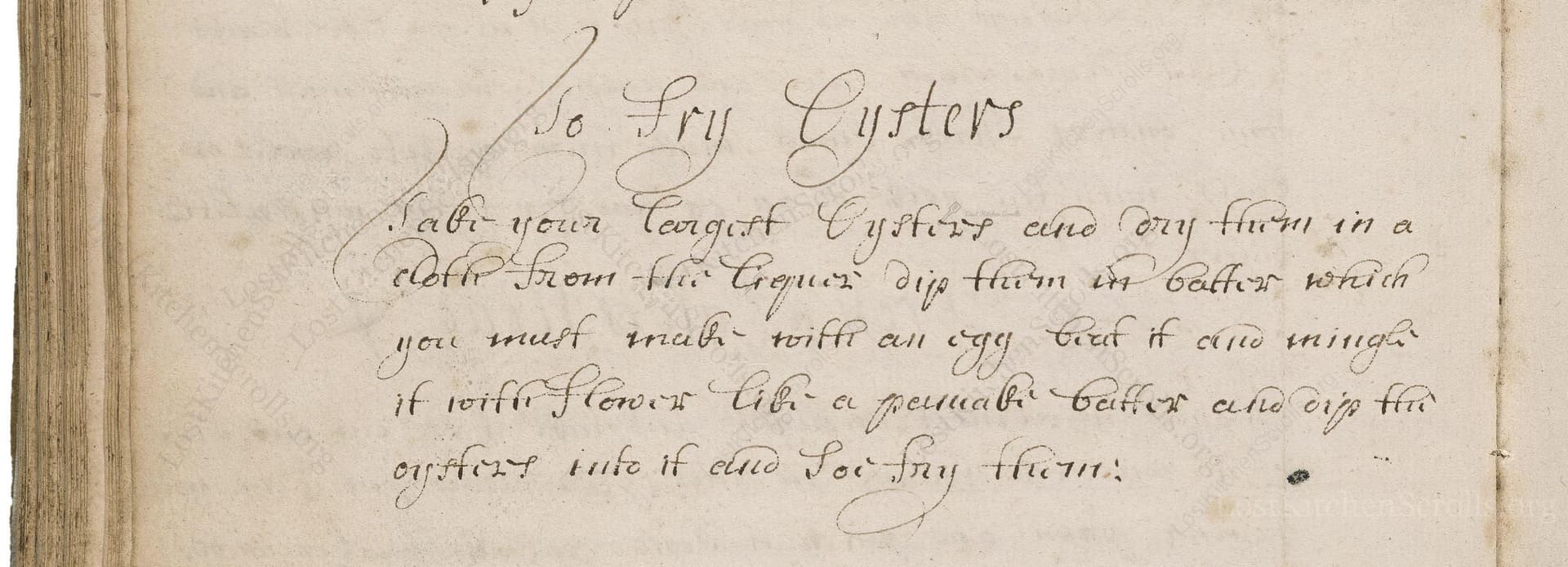
To Fry Oysters
"Take your largest Oysters and Dry them in a Cloath Strow then dip them in Batter which you must make with an egg beat it and mingle it with Flower Like a pannacke Batter and dip the oysters into it and So fry them:"
Note on the Original Text
The recipe is written in the abbreviated and informal style typical of 18th-century manuscript cookery. Spelling is unstandardized—'Flor' for flour, 'pannacke' for pancake, 'cloath' for cloth—which reflected spoken English as much as accepted forms. Instructions assume prior knowledge of common kitchen techniques (like beating eggs or frying) and omit specific amounts, indicating cooks were expected to use their judgement and experience. This concise, flowing prose shows an oral transmission of knowledge, with punctuation and capitals scattered liberally for rhythm rather than strict grammar.

Title
Cookery book of Ann Goodenough (1738)
You can also click the book image above to peruse the original tome
Writer
Ann Goodenough
Era
1738
Publisher
Unknown
Background
A delightful journey into the kitchens of early 18th-century England, this collection captures the flair and flavors of its time with recipes crafted by the inventive Ann Goodenough. Expect a charming medley of hearty roasts, comforting pies, and time-honored confections, perfect for those wishing to dine as they did in Georgian days.
Kindly made available by
Folger Shakespeare Library
This oyster frying recipe comes from the manuscript cookbook of Ann Goodenough, who was active between 1700 and 1775, a period marked by both innovation and tradition in English domestic cookery. Oysters were an everyday, affordable ingredient in Georgian England, enjoyed by households of various means. This simple recipe reflects the era’s fondness for frying, as well as the increasing use of eggs and wheat flour batters—a sign of culinary techniques evolving from medieval to modern. The technique also illustrates the accessibility of protein-rich shellfish to ordinary English cooks in the 18th century, a far cry from their modern status as luxury fare. The recipe’s brevity also hints at the confidence expected of cooks at the time, who were presumed to know the basics.

The oysters would have been shucked using a stout knife. The batter was mixed in an earthenware or wooden bowl with a simple fork or even just a knife. For frying, a heavy iron pan or shallow skillet was set over an open hearth fire. Oysters were typically fried using dripping (animal fat) or possibly a neutral oil, depending on household affluence. Draining was often done using a cloth rather than modern paper towels. The entire process was guided by sight, touch, and smell—there were no thermometers or timers, just experienced hands.
Prep Time
10 mins
Cook Time
10 mins
Servings
3
We've done our best to adapt this historical recipe for modern kitchens, but some details may still need refinement. We warmly welcome feedback from fellow cooks and culinary historians — your insights support the entire community!
Ingredients
- 12 large fresh oysters, shucked
- 1 large egg
- 1/3 cup plain flour (wheat flour)
- Neutral frying oil (sunflower or vegetable; about 2 cups, for shallow frying)
- Pinch of salt (optional, to taste)
Instructions
- Select the largest fresh oysters you can find.
- Drain them well and pat dry with a clean kitchen cloth.
- For the batter, crack one large egg into a bowl and beat it thoroughly.
- Sift in about 1/3 cup of plain wheat flour and whisk together to form a batter with the consistency of pancake batter—smooth and just thick enough to coat the oysters.
- Dip each oyster into the batter, ensuring it is evenly coated.
- In a frying pan, heat enough neutral oil (such as sunflower or vegetable oil; about 1/2 to 3/4 inch deep) over medium-high heat.
- Fry each battered oyster in the hot oil until golden brown on both sides, turning once.
- Drain briefly on paper towel and serve hot.
Estimated Calories
90 per serving
Cooking Estimates
It takes about 10 minutes to prepare the oysters and batter, and another 10 minutes to fry them until they are golden brown. Each serving contains about 90 calories. The recipe makes 12 oysters, which serves 2 to 3 people.
As noted above, we have made our best effort to translate and adapt this historical recipe for modern kitchens, taking into account ingredients nowadays, cooking techniques, measurements, and so on. However, historical recipes often contain assumptions that require interpretation.
We'd love for anyone to help improve these adaptations. Community contributions are highly welcome. If you have suggestions, corrections, or cooking tips based on your experience with this recipe, please share them below.
Join the Discussion
Rate This Recipe

Den Bockfisch In Einer Fleisch Suppen Zu Kochen
This recipe hails from a German manuscript cookbook compiled in 1696, a time whe...

Die Grieß Nudlen Zumachen
This recipe comes from a rather mysterious manuscript cookbook, penned anonymous...

Ein Boudain
This recipe comes from an anonymous German-language manuscript cookbook from 169...

Ein Gesaltzen Citroni
This recipe, dating from 1696, comes from an extensive anonymous German cookbook...
Browse our complete collection of time-honored recipes



